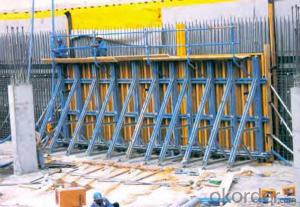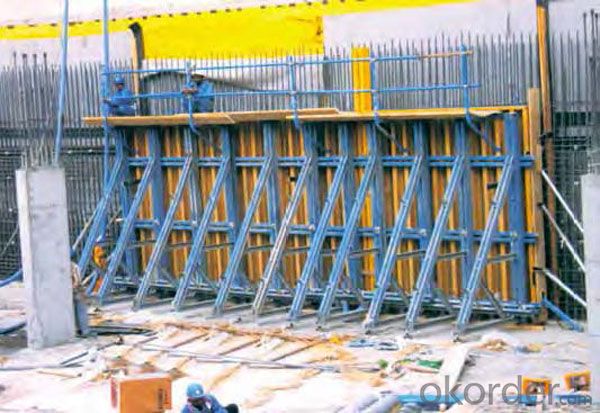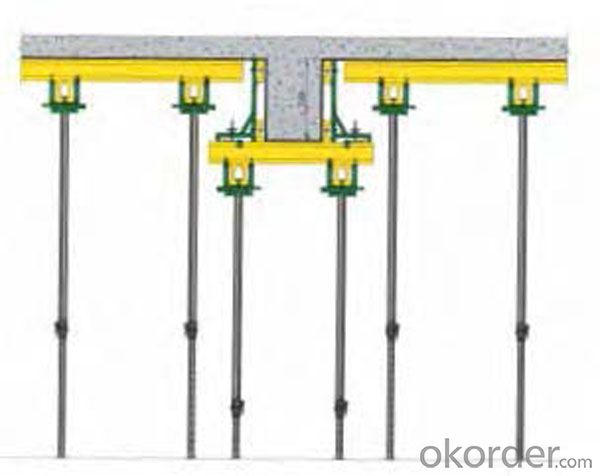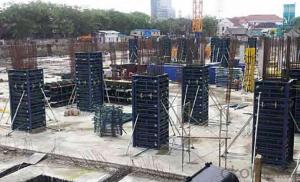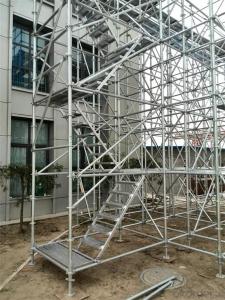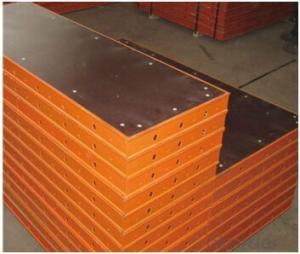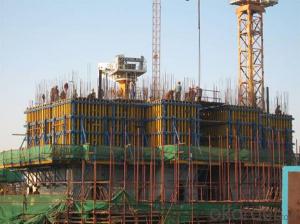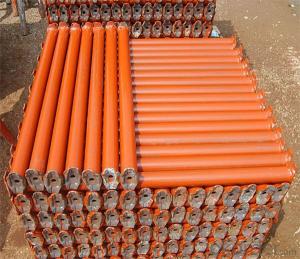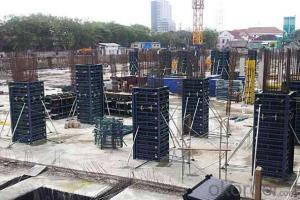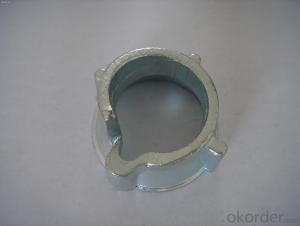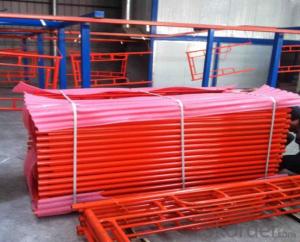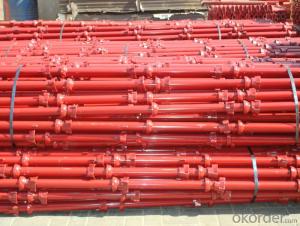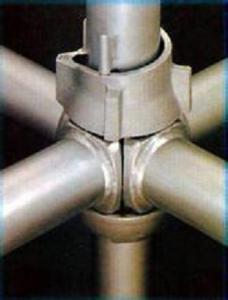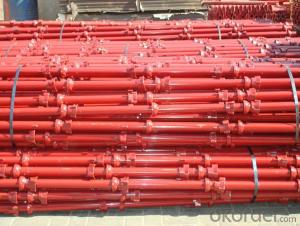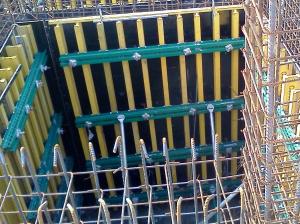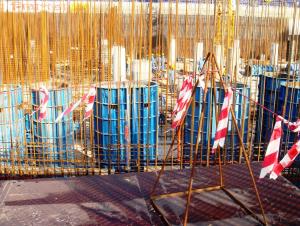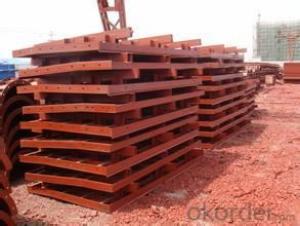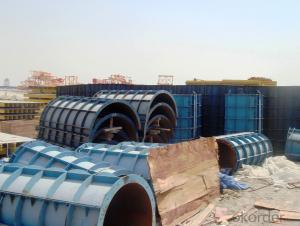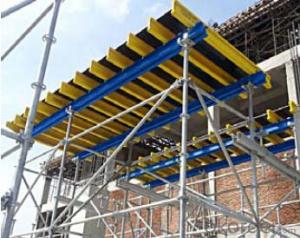Formwork Scaffolding Formwork Cuplock Scaffolding System
- Loading Port:
- Tianjin
- Payment Terms:
- TT OR LC
- Min Order Qty:
- 10000 set
- Supply Capability:
- 50000 set/month
OKorder Service Pledge
OKorder Financial Service
You Might Also Like
Plastic Formwork Concrete Formwork Circular Column Used Scaffolding Props New Design
Developing with new technology materials, steel formworks is no longer a must in construction concrete process. More and more buildings are established with plastic formworks. And workers love this new formworks much more.
The advantages of plastic formworks:
1.First of all--light
Yes it is the first advantage of plastic formwork. It wins the great praise of both contractors and workers.
The biggest panel is 120×1500px,weights 10.5kg only. It can be lift and set up by one person easily, which means there is no need for cranes on site.Saves a lot of cost and time.
2.Easy set up
Different size of panels can firmly locked by simply turn the special handles to 90 degree. The Panels has rib on the back, which makes the system need not traditional wood blocks and nails. The panels have holes to fit tie rod, guarantee the strength of the whole system.
3.Modularity
Modular formworks composed by different size of panels,the main item is 120×1500px panel,which is used for the large area of walls and slabs. There are also small size of panels like 10×1500px,20×1500pxcm,25×1500px,inner corner 20×20×1500px and outer corner 10×5×1500px.Due to the variety of panel size, the system can form almost all size walls 120×1500px panel of multiply by 125px. The material of modular formwork is PC-ABS mixed with special glass fibers which enable panels to hold high pressures.
4.Strength
The handles are made by high strength Nilon, each panel locked by at least 4 handles, which makes the whole system strong enough to pour 1000px walls.
5.Environment friendly
The system needs no cut and nail due to the variety size. Also it needs nearly no wood. The material can be recycled after broken, so it will not pollute the environment.
6.Consequent
Concrete does not stick to plastic formwork, thus the panels need no oil before using, and can be cleaned simply by water. The surface of the wall which build by modular formwork is smooth and without rework.
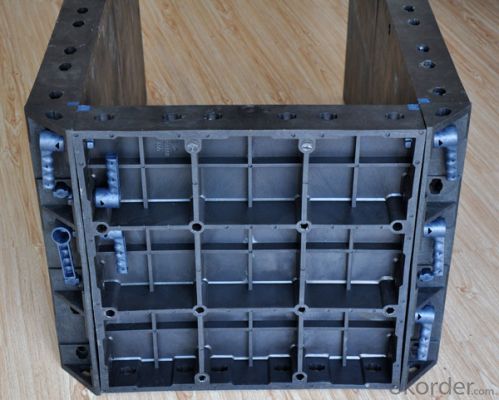
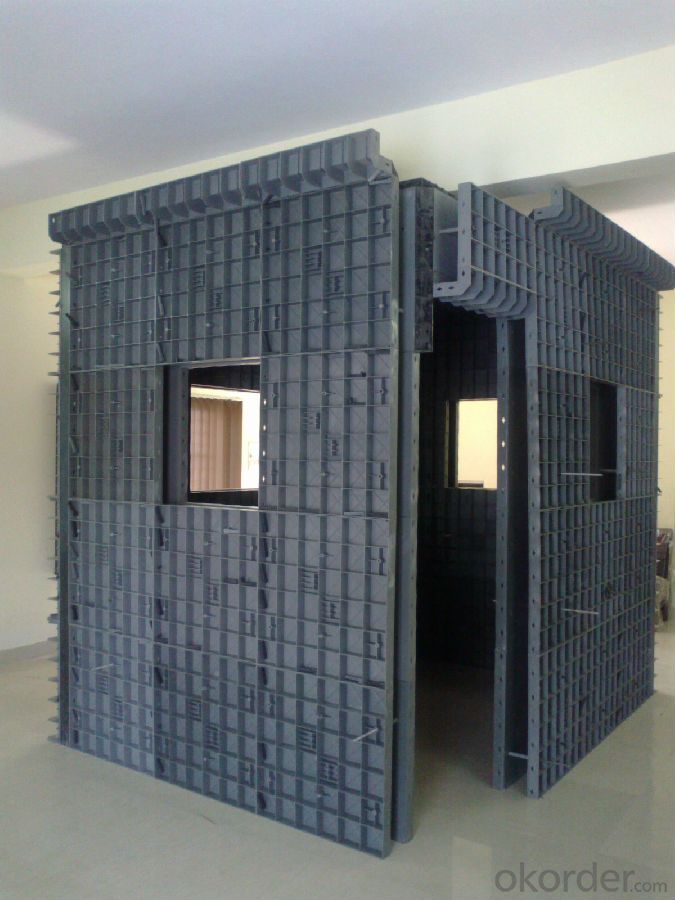
Advantage
* Good loading capacity
* Easy to assemble and dismantle
* Stable and durable thanks to its structual design & automatic welding quality
* Customized solution helps you work safe, save cost and convenient
* Excellent quality for formwork & scaffolding with wide choices
Packing
in bulk or in bundle, or as requested
Shipping
15-20 Days.
Normally small orders, it needs just 15-20 business days to the port. For goods with stock, it would be even shoter.
Other scaffolding & formwork products:
(1) Scaffolding System:
Including Ringlock Scaffolding System and accessories; Cuplock Scaffolding System and accessories; Kwikstage Scaffolding System and accessories; Haki Scaffolding System and accessories;
(2) Scaffolding Frame & Accessories:
Including Walk Through Frame Scaffolding; Ladder Frame Scaffolding; Accessories; we also can make scaffolding according to your samples or drawings.
FAQ
Why Us?
We are one of the Top 500 in the world, largest construction materials supplier in China. Also we are a state-owned company and respond to every customer with large and also small orders.
We own professional manufacturers with powerful producing capacity.
Extensive and comprehensive quality control system
Excellent products with competitive prices.
Efficient services in pre and after sale.
Full energy with affluent experience team.
- Q: How does steel frame formwork handle the placement of embedded items and fixtures?
- The utilization of steel frame formwork in construction projects enables the creation of concrete structures efficiently and with versatility. Several advantages are offered by this system when it comes to managing the placement of embedded items and fixtures. To begin with, steel frame formwork exhibits a high level of adaptability and flexibility. The frames can be easily adjusted and modified to accommodate a range of embedded items and fixtures, including pipes, electrical conduits, and HVAC systems. This facilitates precise positioning and integration of these elements within the concrete structure. In addition, the steel frame formwork system is specifically designed to support the weight of embedded items and fixtures. The frames consist of robust steel sections that can withstand heavy loads, ensuring the formwork's stability and integrity throughout the concrete pouring and curing process. Furthermore, the installation and removal of embedded items and fixtures are efficiently carried out with steel frame formwork. The formwork can be easily dismantled and reassembled, allowing for convenient access during the installation process. This eliminates the need for additional formwork to be created or modified, saving time and effort during construction. Moreover, steel frame formwork guarantees precision in the positioning and alignment of embedded items and fixtures. The frames are designed with accurate measurement systems, enabling precise placement of these elements within the concrete structure. This ensures that the final structure meets the required standards and specifications. In conclusion, steel frame formwork is an ideal choice for managing the placement of embedded items and fixtures in construction projects. Its adaptability, load-bearing capacity, ease of installation, and precision make it a reliable and efficient system for integrating these elements into concrete structures.
- Q: How does steel frame formwork handle the placement of electrical and plumbing systems within the concrete structure?
- The utilization of steel frame formwork is a versatile and efficient approach to constructing concrete structures, encompassing the installation of electrical and plumbing systems. This particular formwork system enables the easy integration of these systems within the concrete structure. The flexibility of steel frame formwork is one of its primary advantages. It can be readily adjusted and modified to accommodate the installation of electrical and plumbing systems. By cutting, drilling, and welding the steel frames, openings and channels can be created to facilitate the placement of electrical conduits and plumbing pipes. Furthermore, the steel frame formwork provides a sturdy and stable structure for these systems. The steel frames offer robust support for the weight of the concrete and the additional load imposed by the electrical and plumbing systems. This guarantees that the systems are firmly embedded within the concrete structure without compromising its integrity. In addition, the steel frames can be prefabricated off-site, enabling precise planning and coordination of the electrical and plumbing layouts. This reduces on-site construction time and minimizes any potential disruptions during the installation of these systems. Moreover, steel frame formwork can accommodate various sizes and configurations of electrical and plumbing systems. The formwork can be customized to meet the specific requirements of the project, whether it entails small-scale residential buildings or large-scale commercial structures. This adaptability ensures the seamless integration of electrical and plumbing systems into the concrete structure without any limitations. Overall, steel frame formwork offers a dependable and efficient solution for managing the installation of electrical and plumbing systems within the concrete structure. Its flexibility, strength, and adaptability make it an ideal choice for construction projects that necessitate the seamless integration of these systems.
- Q: Can steel frame formwork be used in projects with limited formwork storage space?
- Yes, steel frame formwork can be used in projects with limited formwork storage space. Steel frame formwork is designed to be compact and easily disassembled, allowing for efficient storage and transportation. Its modular nature also enables flexibility in adapting to various project requirements and constraints.
- Q: How does steel frame formwork handle different types of structural loads?
- Steel frame formwork is designed to handle different types of structural loads effectively. Its robust and rigid steel frame structure provides excellent strength and durability, enabling it to bear heavy vertical loads. Additionally, the steel frame formwork can efficiently distribute horizontal loads, such as wind or earthquake forces, across its structure, maintaining stability and ensuring the safety of the construction project. The versatility and resilience of steel frame formwork make it an ideal choice for accommodating various types of structural loads.
- Q: Are there any specific safety regulations or standards for using steel frame formwork?
- Yes, there are specific safety regulations and standards for using steel frame formwork. These regulations and standards are put in place to ensure the safe and efficient use of steel frame formwork in construction projects. They may include guidelines for proper installation, bracing, and anchoring of the formwork to prevent collapse or structural failure. Additionally, safety regulations may address fall protection measures, handling and storage procedures, and training requirements for workers using steel frame formwork.
- Q: Can steel frame formwork be used for both cast-in-place and precast wall construction?
- Steel frame formwork is suitable for both cast-in-place and precast wall construction. This versatile and durable system can be adjusted and reused for different construction projects. In cast-in-place wall construction, the steel frame formwork is assembled on-site and used to contain the concrete during pouring and curing. It provides necessary support and shape until the concrete fully hardens. In precast wall construction, steel frame formwork is used to create molds or forms for casting concrete panels or wall sections. The steel frame formwork is designed to withstand the weight and pressure of wet concrete and facilitate the production of accurate dimensions and smooth finishes. Once the concrete cures, the steel frame formwork can be removed and reused for future precast wall production. Using steel frame formwork offers several advantages for both cast-in-place and precast wall construction. It provides high strength and stability, ensuring the integrity and quality of concrete walls. It also enables efficient and precise construction, as the formwork can be easily adjusted and aligned to meet specific design requirements. Additionally, the reusability of steel frame formwork makes it a cost-effective solution for construction projects, reducing material waste and overall expenses.
- Q: How does steel frame formwork support vertical loads?
- The vertical loads are supported by a strong and rigid steel frame formwork, which effectively distributes and transfers the weight and pressure from the concrete. This formwork system is composed of interconnected steel panels, beams, and columns that create a sturdy framework. These elements are designed to withstand the forces and deformations caused by the vertical loads. To transfer the vertical loads, tie rods, braces, and connectors are used to link the concrete slab or beam to the steel frame. These components guarantee the stability of the formwork system and enable it to withstand the pressure exerted by the wet concrete during pouring and curing. The steel frame formwork is also equipped with adjustable props and supports that enhance its stability and flexibility. These props can be modified to accommodate changes in formwork height and to counterbalance any uneven loads. Additionally, the steel frame formwork is designed to be reusable, resulting in cost savings and a more sustainable construction process. The steel components can be easily disassembled, cleaned, and reassembled for use in future projects, making this system incredibly versatile and efficient in supporting vertical loads. In conclusion, the steel frame formwork provides a robust and rigid structure that effectively supports and transfers the weight and pressure exerted by the concrete. Its strong and reusable components ensure stability, durability, and cost-effectiveness in construction projects.
- Q: Can steel frame formwork be used in projects with restricted working hours?
- Yes, steel frame formwork can be used in projects with restricted working hours. Steel frame formwork is a durable and versatile system that can be quickly assembled and disassembled, allowing for efficient construction even with limited working hours. The steel frames provide structural support and can be easily adjusted to accommodate various shapes and sizes of concrete structures. Additionally, steel frame formwork is highly reusable, reducing the need for excessive construction materials and therefore minimizing the time required for formwork installation. Overall, steel frame formwork is a suitable solution for projects with restricted working hours, as it offers flexibility, efficiency, and durability.
- Q: Can steel frame formwork be used for both monolithic and composite concrete structures?
- Yes, steel frame formwork can be used for both monolithic and composite concrete structures. Steel formwork systems are versatile and can be adapted to suit different types of concrete structures. In monolithic structures, the steel frame formwork is used to create a temporary mold or framework that supports the wet concrete until it cures and gains sufficient strength to support itself. This formwork system is commonly used for constructing walls, columns, and slabs in buildings and other structures. In composite structures, steel frame formwork is also used but with an additional layer of reinforcement, such as steel bars or mesh, embedded within the concrete. This reinforcement provides additional strength and durability to the structure. Composite structures are often used in bridges, high-rise buildings, and other heavy-duty applications where increased load-bearing capacity is required. The use of steel frame formwork offers several advantages for both monolithic and composite structures. It provides a strong and rigid support system for the concrete during the construction process, ensuring accurate and precise placement of the concrete. Steel formwork is also highly durable and can be reused multiple times, making it a cost-effective choice for construction projects. Additionally, the modular nature of steel formwork allows for easy assembly and disassembly, saving time and labor on the construction site. Overall, steel frame formwork is a versatile and reliable solution that can be used for both monolithic and composite concrete structures, providing the necessary support and strength required for successful construction projects.
- Q: What types of accessories are available for steel frame formwork?
- Some types of accessories available for steel frame formwork include adjustable formwork clamps, tie rods, formwork connectors, formwork braces, formwork panels, formwork wedges, formwork pins, formwork nails, and formwork supports. These accessories help in securely holding the steel frame formwork in place, connecting different formwork components, providing stability, and facilitating the construction process.
Send your message to us
Formwork Scaffolding Formwork Cuplock Scaffolding System
- Loading Port:
- Tianjin
- Payment Terms:
- TT OR LC
- Min Order Qty:
- 10000 set
- Supply Capability:
- 50000 set/month
OKorder Service Pledge
OKorder Financial Service
Similar products
Hot products
Hot Searches
Related keywords
